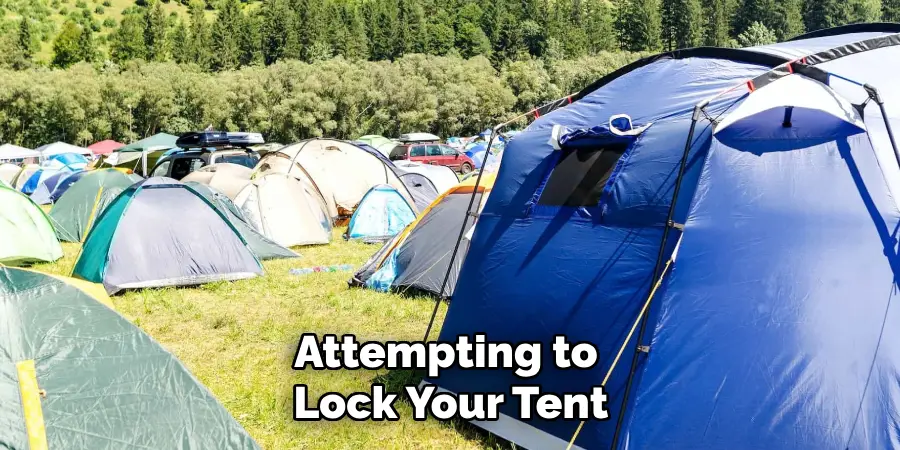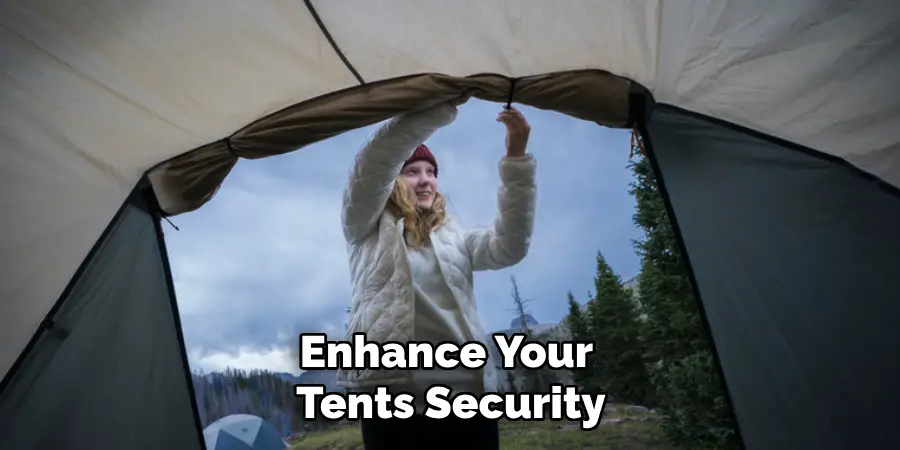Are you planning for a camping trip? Do you want to ensure your tent is secure when you are away from it? Then, how to lock tent is an important step to ensure the safety of your belongings and privacy.

When camping or spending time outdoors, ensuring the security of your tent and belongings is paramount. Although tents are typically made from fabrics that don’t offer the same level of security as solid structures, there are effective ways to deter theft and increase protection. Locking your tent provides peace of mind and acts as a deterrent to potential intruders.
This guide will explore various strategies and techniques for securely locking your tent, empowering you with the knowledge to enjoy your outdoor adventures with confidence.
What Will You Need?
Before we dive into the different methods for locking a tent, let’s first ensure you have all the necessary tools. These are some essential items you may need before attempting to lock your tent:
- A padlock or combination lock
- Cable or chain
- Tent stakes
- Carabiners
- Lightweight rope or cordage
Packing these items with your camping gear is always a good idea, especially if you plan on leaving your tent unattended for extended periods. These tools will be useful when implementing any of the techniques mentioned below.

10 Easy Steps on How to Lock Tent
Step 1: Choose a Lock
Choosing the right lock is the first crucial step towards effectively securing your tent. The lock you select will play a significant role in deterring potential intruders and protecting your belongings. You will need to consider a few factors when making this decision. Firstly, assess the environment and anticipated weather conditions during your camping trip. If there’s a possibility of rain or high humidity, opt for a weather-resistant lock to prevent rusting or corrosion.
Additionally, think about the size and type of lock that best fits your needs. A padlock with a key or a combination lock that fits through the tent’s zippers is often a practical choice. Some campers prefer using combination locks for convenience—there’s no risk of losing keys. However, consider the level of security you’re comfortable with, as more sophisticated locks may offer higher resistance to tampering.
Finally, ensure the lock is lightweight and portable so it doesn’t add significant weight to your camping gear.
Step 2: Assess Vulnerable Areas
Identify the most vulnerable areas of your tent that may need securing. Typically, these areas include the zippers, doors, and possible entry points. Check for openings or seams that might be easily bypassed and ensure they are well protected. Understanding which sections of your tent are most susceptible allows you to target your security measures effectively, maximizing deterrence and protection.
Prioritize securing access points that would otherwise allow easy entry, and consider using locks or other devices to reinforce these areas against unauthorized access.
Step 3: Use a Cable or Chain
To enhance your tent’s security, thread a cable or chain through the tent’s zippers or securing loops. This method not only provides an additional layer of protection but also acts as a strong deterrent against potential intruders. Choose a lightweight cable or chain that is strong enough to resist cutting attempts. Securely fasten it with a padlock or a combination lock.

This setup prevents easy access through zippers and reinforces the tent against tampering. Remember to ensure the cable or chain does not damage the tent material, and keep it tight to avoid tripping hazards.
Step 4: Secure with Tent Stakes
Firmly anchor your tent to the ground using tent stakes, which help prevent your tent from being easily moved or shifted. This method secures the base of your tent, making it more difficult for intruders to lift or carry it away. Ensure the stakes are driven deeply into the ground at an angle, maximizing their hold. Consider using stakes with a hook or loop feature, as these provide additional points to secure cables or chains.
Properly staking your tent enhances stability and security, reducing the likelihood of theft when you are away.
Step 5: Utilize Carabiners
Carabiners are versatile tools that can provide extra security for your tent. Use carabiners to fasten zipper pulls or loops together, making it more difficult for someone to open the tent quickly. They are lightweight and easy to carry, and their locking feature adds layer of protection against unwanted entry. Choose carabiners that are sturdy and have a reliable locking mechanism.
Attach them to various points where zippers meet or securing loops, effectively creating a more secure enclosure. This step will significantly hinder unauthorized access, ensuring peace of mind while enjoying the outdoors.
Step 6: Use an Alarm System
Incorporating a small, portable alarm system can significantly enhance the security of your tent. These alarms can be attached to zippers or entry points and emit a loud noise if the tent is tampered with. Choose a device that is easy to install and designed for outdoor use to withstand weather conditions. Alarms are an excellent deterrent by alerting you and others nearby to potential intruder activity.
Test the alarm before use to verify its effectiveness and battery life. This additional measure provides another layer of protection, allowing you to relax more comfortably on your camping trip.
Step 7: Set Up a Perimeter
Creating a perimeter around your tent using natural or artificial barriers can be an additional security measure. Arrange branches, rocks, or other materials a few feet from your tent to deter potential intruders or alert you to someone approaching. Alternatively, you can use motion-activated lights or attach noise-making devices to the perimeter, which will activate if disturbed.
This extra boundary serves as a preliminary warning system and can be effective in isolated or less crowded camping areas. Combining a perimeter with other security strategies enhances your tent’s protection and creates a safer camping experience.
Step 8: Utilize Lightweight Rope or Cordage
You can create additional securing points for your tent using lightweight rope or cordage. Tie the rope between trees or sturdy structures to form a makeshift barrier, or create tripwires around your campsite. Cordage can also reinforce tent stakes or secure additional tarps for privacy and protection. Ensure the rope is tightly fastened and not easily visible,
both for effectiveness and to avoid accidental tripping. This method extends your security beyond the immediate tent, offering more comprehensive coverage to deter potential intruders from approaching your camping area.

Step 9: Keep Valuables Hidden Inside
Store your valuables in a secure, inconspicuous location within your tent to prevent them from drawing attention. Utilize hidden compartments, backpacks, or other storage options that are not immediately visible to outsiders. Consider placing items under sleeping bags, clothing, or within less accessible areas of the tent. Keeping your personal belongings well-concealed reduces the temptation for potential thieves and adds an extra layer of security.
It’s a simple yet effective measure that ensures your valuables remain safe while you explore the great outdoors. Always remember to take essential items with you when leaving the campsite to minimize risk.
Step 10: Be Aware of Your Surroundings
Maintaining awareness of your surroundings is crucial to ensuring the security of your tent and belongings. Familiarize yourself with the campsite layout and identify potential security vulnerabilities, such as secluded areas or crowded spots where theft is more likely. Pay attention to the behavior of those around you and trust your instincts if something seems off.
Additionally, make sure your camping gear is easily accessible and organized, allowing you to secure your tent and valuables if needed quickly. By staying vigilant and observant, you can better protect your campsite from unwelcome visitors and enjoy a safer outdoor experience.
By following these steps, you can significantly enhance the security of your tent and belongings while camping.
5 Things You Should Avoid
- Using Incompatible Locking Mechanisms: Avoid using locks or mechanisms that are not designed for tent materials, as they may damage the fabric or zippers. Ensure every lock or security device is suitable for outdoor use and compatible with your tent’s design to prevent unnecessary wear or issues with functionality.
- Overloading the Tent with Heavy Chains: While securing your tent with locks and cables is important, using excessively heavy chains can damage or collapse lightweight camping structures. Opt for lightweight, strong materials that provide security without compromising the tent’s structural integrity.
- Ignoring Weather Conditions: Pay attention to the impact of weather conditions on the security tools you use. Rain, wind, and extreme temperatures can affect how well your locks, alarms, or barriers function.
- Leaving Security Gaps: Avoid leaving any apparent gaps in your security measures, such as unsecured doors or windows. Thieves can easily exploit these weak points. Take time to secure every entry point and double-check that all protective mechanisms are properly engaged before leaving your tent unattended.
- Neglecting Regular Inspections: Failing to check your security setup regularly can lead to vulnerabilities over time. Make it a habit to inspect all locks, cables, and alarm systems for damage or wear.

Conclusion
How to lock tent effectively involves a combination of thoughtful preparations and practical strategies.
Implementing the measures outlined above—from using appropriate locking mechanisms and alarm systems to setting up perimeters and staying vigilant of your surroundings—can greatly enhance your tent’s security. It’s essential to opt for solutions that do not compromise your tent’s structural integrity while ensuring every precaution is tailored to withstand varying weather conditions. Prioritizing a balance between security and functionality will safeguard your personal belongings and enrich your overall camping experience by providing peace of mind.
Regularly inspect and adapt your security strategies to address potential vulnerabilities, ensuring a safe and enjoyable outdoor adventure.
